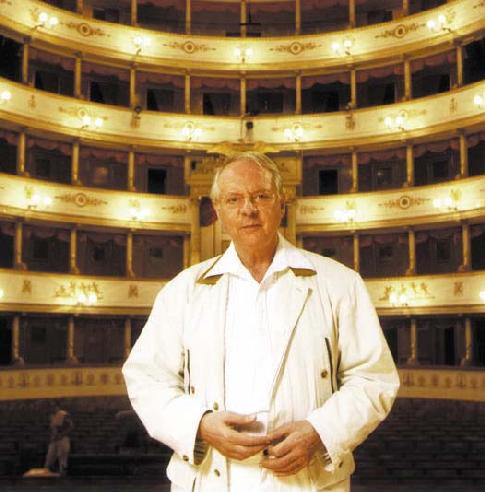
Karlheinz Stockhausen

Karlheinz Stockhausen was born in the village of Mödrath. His father was a schoolteacher and his mother was the daughter of a prosperous family of farmers in Neurath in the Cologne bight. She played the piano and accompanied her own singing but, after three pregnancies in as many years, experienced a mental breakdown and was institutionalized in December 1932. She would later be killed by the Nazis.
Stockhausen grew up in Altenberg from the age of 7, where he received his first piano lessons from the Protestant organist of the Altenberg Cathedral, Franz-Josef Kloth. His father, Simon Stockhausen, remarried in 1938 and with his new wife Luzia, had two daughters. Because his relationship with his new stepmother was less than completely happy, in January 1942 Karlheinz went to become a boarder at the teachers' training college in Xanten, where he continued his piano training, and also studied oboe and violin.
In the Autumn of 1944 he was drafted as a stretcher-bearer in Bedburg. In February 1945, he met his father for the last time in Altenberg. Simon told his son he would not be coming back from the Eastern Front .
From 1947 to 1951 Stockhausen studied music pedagogy and piano at the Cologne Musikhochschule, and musicology, philosophy, and Germanics at the University of Cologne. Although he had the usual training in harmony and counterpoint, the latter with Hermann Schroeder, it was only in 1950 that he developed a real interest in composition, and was admitted at the end of the year to the class of the Swiss composer Frank Martin, who had just begun a seven-year tenure in Cologne. At the Darmstadt Summer Courses in 1951 he met the Belgian composer Karel Goeyvaerts, who had just completed studies with Olivier Messiaen and Darius Milhaud in Paris, and Stockhausen resolved to do likewise. He arrived in Paris on 8 January 1952, and began attending Messiaen's courses and Milhaud's classes. In March 1953 he left Paris to take up a position as assistant to Herbert Eimert, at the newly established Electronic Music Studio of NWDR in Cologne. From 1954 to 1956 he studied phonetics, acoustics, and information theory with Werner Meyer-Eppler at the University of Bonn. Together with Eimert, he edited the influential journal Die Reihe from 1955 to 1962.
After lecturing at the Internationale Ferienkurse für Neue Musik at Darmstadt (first in 1953), Stockhausen gave lectures and concerts in Europe, North America, and Asia. He was guest professor of composition at the University of Pennsylvania in 1965, and at the University of California, Davis, in 1966-67. He founded and directed the Cologne Courses for New Music from 1963 to 1968, and in 1971 was appointed Professor of Composition at the National Conservatory of Music, where he taught until 1977.
In 1961 he acquired a parcel of land in the vicinity of Kürten, a village east of Cologne, near Bergisch Gladbach in the Bergisches Land. He had a house built there, designed to his specifications by the architect Erich Schneider-Wessling, where he resided since its completion in the autumn of 1965. In 1998, he founded the Stockhausen Courses, held annually in Kürten.
His most famous works include: Gruppen (1955-7), Kontakte (1962), Prozession (1967) and Lichte (1977-2003)
Marion Boyars titles by Stockhausen: